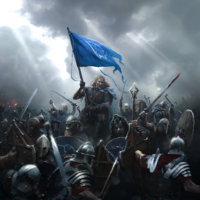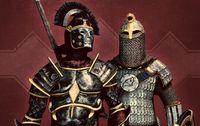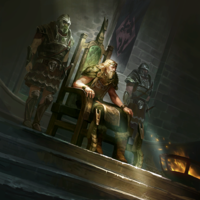Lore:Stormcloak Rebellion
| Stormcloak Rebellion | |
|---|---|
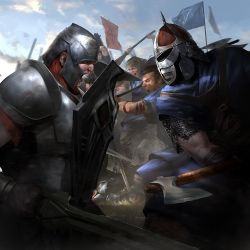 A battle between the Legion and the Stormcloaks |
|
| Date | 4E 201 |
| Location | Skyrim |
| Result | Unknown |
| Participants | |
| Third Empire | Stormcloaks |
| Commanders and Leaders | |
|
|
The Stormcloak Rebellion, also known as the Skyrim Civil War[1] and Ulfric's Uprising,[2] was a civil war in Skyrim circa 4E 201. It was fought between the forces of the Third Empire, mobilized in western Skyrim, and the Stormcloak rebels of eastern Skyrim. The war saw two claimants to Skyrim's throne fight against each other, with the Empire supporting Elisif the Fair's claim of High Queen and the Stormcloaks insisting Jarl Ulfric Stormcloak had earned his right as High King.[3]
Contents
Background[edit]
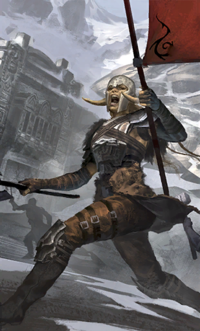
Lead-up to Conflict[edit]
During the Great War between the Third Empire and the Aldmeri Dominion, Nordic legionaries were crucial to the Empire's survival, but this left the Reach undefended when the native Reachmen rebelled against the Nordic occupation and declared their independence. The Reach was relatively peaceful and fair during the period and applied for status as an Imperial Province.[4] Concurrently, Ulfric Stormcloak of Windhelm left his tutelage under the Greybeards to fight in the war,[5] during which he was captured by the Thalmor. Ulfric was tortured and led to believe the information he had given up led to the capture of the Imperial City, though it had already fallen and the information he gave up was considered inconsequential.[6]
Ulfric, after escaping, formed the Stormcloaks as a militia. Without Imperial assistance, they successfully retook the Reach from the native inhabitants who had overthrown the Nords. After the Empire sent soldiers to re-establish control, Ulfric Stormcloak demanded free worship of Talos, which had been outlawed under the White-Gold Concordat that ended the Great War.[4] The Empire, which was already fairly lax in their enforcement,[7] reluctantly granted it, hoping the Dominion would not find out. When the Thalmor demanded the Stormcloaks' arrests, with a second Great War on the line, Jarl Hrolfdir of Markarth obeyed, sending Ulfric to an Imperial prison for seven years from 4E 176 to 4E 183.[4][5][8]:877 Supporters of the militia called the event 'The Markarth Incident',[9] and it caused the Empire to crack down on Talos worship across Skyrim.[7]
Pre-War Skirmishes[edit]
Some felt the Stormcloak Rebellion truly began with The Markarth Incident. Indeed, the first hostilities arose when Ulfric was released from prison and took over his late father's position as Jarl of Windhelm.[8]:877 A skirmish between Imperial forces and the growing Stormcloak militia occurred outside of the city.[10][11] The victor of this clash is unknown, but the Legion was reported burning the bodies of the deceased.[12] Despite these conflicts, the Stormcloaks did not gain much support from the general populace.[13]
Soon after the High King of Skyrim, Istlod, died, Ulfric called a Moot to choose a new High King. As Istlod's son, Torygg, was already set to take the throne, Ulfric used the opportunity to air his grievances against the Empire and rally the Jarls for Skyrim's independence in nearly treasonous terms. Torygg himself admired Ulfric and was sympathetic to his cause. In early 4E 201, Ulfric arrived at the Blue Palace, let in by the guards under the presumption that he was there to ask the High King to declare independence. Torygg was caught off guard when Ulfric challenged him to a duel over his allegiance to the Empire.[14] Even though he knew he could not best Ulfric in combat, he recognized his honor would be stained by denying him and accepted.[15] Ulfric killed Torygg using the Thu'um before running him through with his sword, and fled the city pending arrest. He was branded a murderer and traitor by the Empire,[16] while some Nords believed the duel was legal and true to the old ways of Skyrim, thus officially starting the Stormcloak Rebellion.[17]
The War[edit]
Logistics and Allegiances[edit]
Several military forts in Skyrim were occupied by bandits during the war, limiting strategic garrisoning on both sides.[18][19] Emperor Titus Mede II was hesitant to send aid, as it would be weakening the border with the Aldmeri Dominion. In conjunction with an avalanche in Pale Pass, the emperor's aversion meant Skyrim had to fend for itself, largely.[20][21] General Tullius was brought in from Cyrodiil at the emperor's request to quell the rebellion, instilling faith among both his soldiers and the Imperial citizenry. However, his forces were limited, commanding only "a bare handful of legions".[21] At one point, the emperor sent Tullius intelligence regarding the whereabouts of the Lord's Mail, intending for Tullius to wear the relic and boost morale.[22] Both the Legion and the Stormcloaks were forced to rely upon local recruits to bolster their numbers.[23][24]
The western portion of Skyrim, including the Holds of Haafingar, Hjaalmarch, the Reach, and Falkreath, remained under Imperial control, with Torygg's wife Elisif the Fair taking the role of Jarl of Solitude, supported by the Empire for High Queen.[18] In the east, the Old Holds of Eastmarch, Winterhold, the Pale, and the Rift[25] supported the Stormcloaks, with Ulfric maintaining his position as Jarl of Windhelm, the ancient capital of Skyrim.[18] Whiterun remained the only neutral Hold at the onset of the war, with Jarl Balgruuf the Greater torn between conflicting loyalties to the Empire and Skyrim. He continued to privately worship Talos and allowed free worship of the god in his city, but felt that the true enemy remained the Aldmeri Dominion and that the White-Gold Concordat was necessary to maintain peace.[26]
Notable Events[edit]
On the 15th of Last Seed,[nb 1] Ulfric and a small cohort of his men were ambushed by the Legion outside Darkwater Crossing in southern Eastmarch. After surrendering, the prisoners were carted for two days until they arrived in Helgen for execution, stopping short of their planned destination, Cyrodiil.[13] The Thalmor attempted to intervene and prevent Ulfric's execution, as they considered him an asset,[6] but this attempt was unsuccessful, and Ulfric was lined up for the chopping block.[21]
In a twist of fate, the village was suddenly attacked by the dragon Alduin, allowing some prisoners, including Ulfric and the Last Dragonborn, to escape. Alduin's attack signaled the return of dragons to Skyrim, a sign of the End Times in Nordic culture.[13] This event took all sides unawares, including Thalmor observers, and the war meant many cities and settlements could not commit resources to defend themselves from the dragons.[27] During the Dragonborn's quest to end the dragon menace, they needed to use Whiterun's castle to capture and interrogate one of Alduin's allies. The Dragonborn was forced to engage in the civil war to prevent any assault on Whiterun from disrupting the capture, but it is unknown if they chose to pick a side and fight in the war or arrange a peace council and temporary ceasefire at High Hrothgar.[26][28][29]
At some point after Ulfric's escape, the Stormcloaks attempted to establish correspondence with High Rock and request aid in the war effort, but received no response.[5][19]
Both sides sought to increase the legitimacy of their claimant to the throne of Skyrim by obtaining the Jagged Crown, an ancient sign of office lost with High King Borgas in the First Era. It was discovered by both the Legion and Stormcloaks in Korvanjund, causing the two sides to battle in the ruin over possession of the artifact.[19]
Eventually, Jarl Balgruuf was forced to end his neutrality and pick a side in the war after Ulfric issued his ultimatum in the old way; sending him his axe. Balgruuf, after consulting his court, decided to side with the Empire, reluctantly allowing General Tullius to marshall troops in his city.[26] Shortly after his decision, enemy forces would arrive, initiating the Battle for Whiterun. Getting the drop on the Imperials, the Stormcloaks were able to set up catapults and begin bombarding the city with flaming projectiles. The defending forces utilized water brigades to combat the flames.[30][26]
Ultimately, the outcome of the war is unknown. Some Stormcloak officers feared that all their gains in the rebellion would be for naught after receiving word of an increasingly large Imperial force on the other side of Pale Pass.[31]
Aldmeri Dominion Involvement[edit]
The leaders of the Stormcloaks and the Legion both saw the war as a proxy conflict with the Aldmeri Dominion, who closely watched the situation.[21][5] The Dominion had not anticipated the war and were conflicted on how they should respond. On the one hand they, like both the Stormcloaks and Legion, thought a second Great War was inevitable, and wanted to weaken the Empire for that purpose. However, the Thalmor enjoyed significant leeway and influence in Skyrim that would be lost if the province became independent under the Stormcloaks, and so publicly supported the Empire. At the same time, they wanted the Empire to be weakened by the war and keep its attention to its north, not towards preparing for conflict with the Dominion. Ultimately, they decided it was in their best interest to prolong the conflict as much as possible and preserve the status quo,[6] despite rumors that they had assisted the Legion in the ambush at Darkwater Crossing which nearly ended the war.[8]:347
Known Martial Conflicts[edit]
- Massacre at Karthwasten. A supposed massacre carried out by Stormcloak forces, avouched by the Legion and denied by the Stormcloaks.[18][19]
- Assault of Fort Neugrad. An assault on Imperial-controlled Fort Neugrad. The defenders succeeded in repelling the attack but were left dangerously vulnerable.[20]
- Skirmish in Whiterun. A Stormcloak victory over an Imperial scouting party in Whiterun Hold.[16]
- Ambush at Giants' Gap. A Legion ambush launched on a Stormcloak force who soon defended themselves with a shield wall. The victor is unknown.[32]
- Ambush at Darkwater Crossing, 15th of Last Seed.[nb 1] A Legion ambush enacted upon a Stormcloak company including Ulfric Stormcloak himself near the border. The attack was successful, leading to Ulfric's - and, incidentally, the Last Dragonborn's - capture.[13]
- Battle of Stony Creek. A clash of unknown victor between the opposing factions.[33]
- Clash at Korvanjund. An encounter between the two parties at Korvanjund, each side wishing to obtain the Jagged Crown. The victor is unknown.
- Battle for Whiterun. A Stormcloak siege attempting to capture Imperial-aligned Whiterun. The victor is unknown.
- Battle of the Champions. An organized engagement between the opposing forces, proposed by the Stormcloaks.[34][35] A champion from each faction dueled in the fields of Whiterun Hold, backed up by a small squad of allied soldiers.[36] It held negligible militaristic gain, being accepted only for purposes of boosting morale.[37]
Notes[edit]
- The Tarot Deck and Guidebook features Strength, a card depicting Ulfric Stormcloak, with a description detailing him winning the rebellion. However, Tori Schafer, the books author, confirmed this description was only of a possible outcome.
- A cut quest from Skyrim's Civil War questline would have had the player bring a Giant named Goldar a painted cow as a peace offering, an old tradition from when there were more Giants in the world.[UOL 1] The Painted Cow concept made it into the final game; the player may find farmers in random encounters on journeys to present their cow to the Giants as a peace offering to cease attacks on their farms.[38] This worldbuilding item was adopted from the unofficial text The Seven Fights of Aldudagga, by Michael Kirkbride.[UOL 2]
See Also[edit]
- For game-specific information, see the Skyrim article.
References[edit]
- ^ a b Card Lore - Markarth Bannermen
- ^ Ulfric's Uprising in Legends
- ^ Gerdur's dialogue in Skyrim
- ^ a b c The Bear of Markarth — Arrianus Arius, Imperial Scholar
- ^ a b c d Ulfric Stormcloak's dialogue in Skyrim
- ^ a b c Thalmor Dossier: Ulfric Stormcloak
- ^ a b Alvor's dialogue in Skyrim
- ^ a b c The Elder Scrolls V: Skyrim: Legendary Prima Official Game Guide — David Hodgson
- ^ Igmund's dialogue in Skyrim
- ^ Solaf's dialogue in Skyrim
- ^ Vulwulf Snow-Shod's dialogue in Skyrim
- ^ Nura Snow-Shod's dialogue in Skyrim
- ^ a b c d Hadvar's dialogue in Skyrim
- ^ Sybille Stentor's dialogue in Skyrim
- ^ High King Torygg's dialogue in Skyrim
- ^ a b Captain Aldis' dialogue in Skyrim
- ^ Roggvir's dialogue in Skyrim
- ^ a b c d Legate Rikke's dialogue in Skyrim
- ^ a b c d Galmar Stone-Fist's dialogue in Skyrim
- ^ a b Imperial Missive
- ^ a b c d General Tullius' dialogue in Skyrim
- ^ Letter to General Tullius — Emperor Titus Mede II
- ^ The Holds of Skyrim
- ^ Nords Arise! — Anonymous
- ^ Pocket Guide to the Empire, 1st Edition: Skyrim — Imperial Geographical Society, 2E 864
- ^ a b c d Jarl Balgruuf the Greater's dialogue in Skyrim
- ^ Jouane Manette's dialogue in Skyrim
- ^ Jarl Vignar Gray-Mane's dialogue in Skyrim
- ^ Events of Season Unending in Skyrim
- ^ Legate Quentin Cipius' dialogue in Skyrim
- ^ Stormcloak Missive
- ^ Stormcloak Soldier's dialogue in Skyrim
- ^ Events of Eastmarch Camp in Legends
- ^ Battle of Champions
- ^ Yrsarald Thrice-Pierced's Note — Yrsarald Thrice-Pierced
- ^ Events of Battle of the Champions in Skyrim: Civil War Champions
- ^ Legate Adventus Caesennius's Note — Legate Adventus Caesennius
- ^ World Interactions in Skyrim
Note: The following references are considered to be unofficial sources. They are included to round off this article and may not be authoritative or conclusive.
|
|||||||||||||||||||||||||

